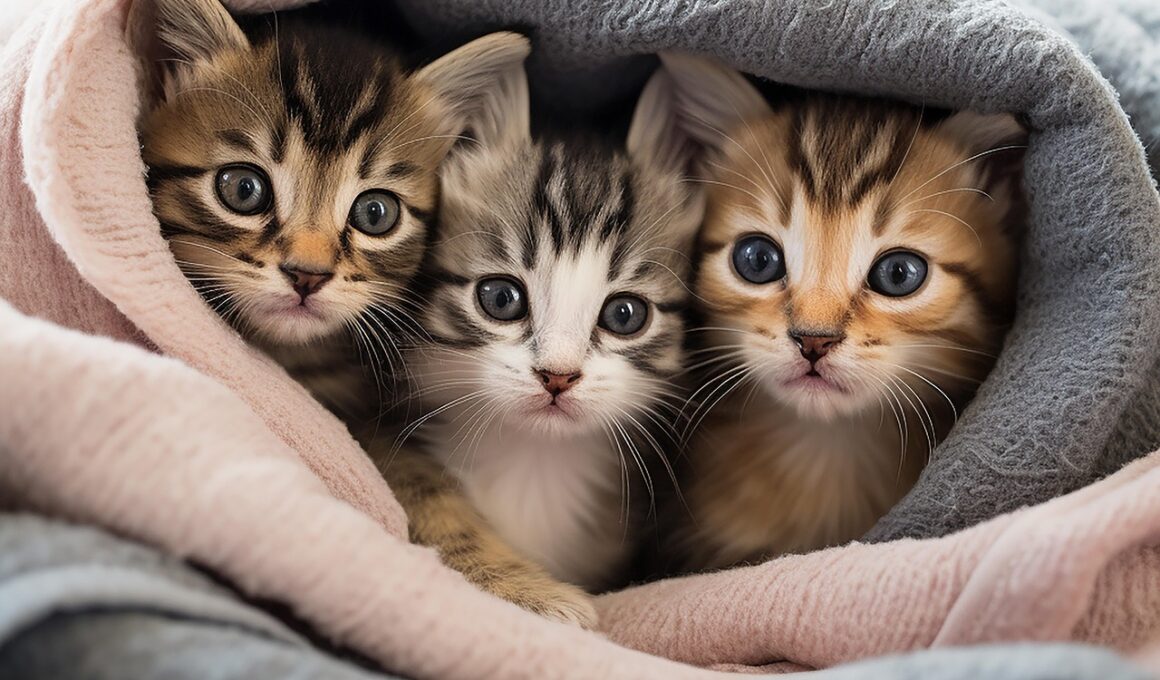Avoiding Common Mistakes in Slow Cat Introductions
When introducing cats, many common mistakes can hinder the process. One of these issues arises when cat owners rush the introduction phase. Rapid introductions lead to unnecessary stress and anxiety for both animals. Hence, it’s critical to allow time for adjustment. Cats are territorial by nature, and sudden changes may provoke aggression. Understanding feline behavior is key to ensuring satisfaction for both cats. Another mistake involves neglecting to provide separate spaces during introduction. Each cat needs a safe area where they can retreat and feel secure. This measure allows them to adapt at their own pace. Additionally, ignoring positive interactions between the cats can also be detrimental. It’s important to facilitate and reward positive encounters, ensuring the experiences are enjoyable. The use of treats can promote a sense of shared pleasure. Furthermore, not utilizing scent swapping often leaves cats feeling unfamiliar with each other. To reduce stress, exchanging bedding or toys can be helpful. Overall, avoiding these mistakes ensures a smoother transition in socializing your pets, leading to a more harmonious environment in your home.
Understanding Feline Behavior
Understanding feline behavior is foundational for successful introductions. Cats communicate largely through body language, and recognizing these signals can prevent misunderstandings. For example, prolonged staring can be perceived as a threat by some cats. Similarly, a hissing sound often indicates fear or displeasure. Observing these behaviors allows cat owners to gauge the emotional state of their pets. Additionally, composition matters, as environments can deeply influence a cat’s behavior during introductions. Ensure that the area is quiet, without sudden noises that could create anxiety. Introducing calming pheromones may also help ease tensions. Moreover, players should be attuned to each cat’s individual temperament; some may be more sociable while others prefer solitude. Assessment of their unique personalities considerably aids in formulating a personalized approach. Gradually increasing their contact by utilizing barriers like gates allows them to see and smell each other without direct interaction. Lastly, patience is essential during this process, as forcing interactions is often counterproductive. Each cat requires a distinct time frame to adjust, and understanding this can create a more inviting pathway toward socialization.
Establishing routines is an effective way to make introductions smoother. Cats thrive on predictability, and having set schedules can ease their stress. When feeding, playtimes, and habitat interactions are consistent, they are less likely to feel chaotic disruptions. Another common pitfall is overlooking the necessity of gradual exposure. Continuous exposure techniques, such as scheduled meetings, can encourage curiosity between the cats. Introducing calming musical sounds can also assist in reducing anxiety levels during their encounters. Importantly, using high-value treats aids in fostering an association of positivity with each other’s presence. Conversely, if only negative distractions occur—like loud noises or confrontations—the process becomes detrimental. Another mistake occurs when one cat is allowed more freedom than the other. Ensuring both cats are treated equally during the introduction process fosters fairness and decreases jealousy. Additionally, monitoring their interactions and providing appropriate distractions in the form of toys can help redirect potential aggression. All these strategies are not only beneficial for initial introductions but also in sustaining long-term relationships. They nurturally enhance shared experiences, which can lead to friendship between the feline companions.
Meet and Greet Protocols
Implementing appropriate meet and greet protocols is crucial for success in slow introductions. These protocols should begin with brief initial meetings, allowing both cats short interactions supervised by their owners. If one cat displays signs of stress, it is important to back off and provide comfort. Sparingly allowing interaction diminishes fears, ensuring they each associate positivity with the presence of one another. During the meet and greet, cat owners should be observant, looking for signs of discomfort or aggression. Employing distraction techniques can also help minimize tension. For example, interjecting with engaging toys can redirect their focus away from any negative encounters. Plus, setting up an escape route will allow either cat to disengage safely. Create an environment where they can observe each other without direct confrontation. This measure can help with acclimatization. Owners must remain calm, as their attitudes heavily influence the cats’ reactions. Incorporating exciting scents, such as catnip, can subsequently increase curiosity, transforming introductions into enjoyable experiences. Frequent short meetings lead to familiarity, making the process less daunting. As time progresses, longer encounters can be scheduled for smooth transitions.
A significant aspect of slow introductions is ensuring that each cat has a secure den. This refuge must always remain available to both parties; most cats need a safe space to retreat when feeling overwhelmed or anxious. Failing to provide such an area can result in stress-driven behaviors, such as hiding, scratching, or aggressive postures. Moreover, introducing an environment filled with familiar scents can enhance security and promote comfort. Using carriers during transitional encounters can create a controlled space, familiarizing them with each other without physical confrontation. Another critical element includes avoiding direct eye contact, as this can come off as a challenge or a threat. Lastly, allowing for gradual integration permits a deeper understanding of their developing relationships. One should utilize soft distractions, such as toys or treats, during introductions while remaining attentive to the behaviors displayed. Once they exhibit friendly behaviors, further interactions can be encouraged. It’s important to document their progress to identify issues or breakthroughs. By taking the time to monitor these moments, you will create a well-rounded approach to feline socialization, fostering sustainable relationships.
Consistency and Patience
Consistency and patience are your greatest allies when socializing cats. Repeating policies and techniques fosters familiarity, while the cats become accustomed to each other’s presence. Spend time observing their interactions, allowing for the development of trust. If a setback occurs, revisit prior successful strategies, as the timeline for each cat may differ significantly. Consistency in rules, such as where they can explore and what is allowed during introductions, keeps them focused. An emotionally steady routine aids immensely in the transition, setting expectations for behavior. Furthermore, patience prevents frustration and ensures both animals can progress. Keep a calm demeanor, as your energy significantly impacts their feelings. Engaging in shared activities can encourage bonding too, allowing them to associate interactions with positive reinforcement. Activities like playing with a joint toy or having a simultaneous treat session can foster connectedness. Allow them to create their paths, and resist the urge to force relationships. Acceptance of time is vital; every cat has its pace for adaptation. Eventually, your commitment to patience and structure promotes a healthy coexistence among your feline friends that withstands the test of time.
To conclude, adapting slow introduction techniques for cats requires thoughtfulness and a willingness to learn. Avoiding common mistakes significantly increases the likelihood of positive interactions, allowing both cats to thrive in their environment. In doing so, recognize that not all steps of the process may go as planned. Resilience is essential; should conflicts arise, revert to implementing gradual measures that previously worked. Being observant can help predict behaviors before they escalate. Support through reassurance and reward instills confidence in your pets, ensuring future meetings are less stressful. Consistent management paves the way to a cooperative future between your felines. Engaging in socialization opens up avenues for fun while enhancing their psychological wellbeing. Following these steps, cat owners build relationships based on acceptance and harmony. Last but not least, keep in mind that every cat is a distinct individual, and their unique personalities must be respected throughout the introduction journey. This will help to ultimately create a safe place for every furry friend. With time and diligence, cats can develop friendships that enrich their lives, making a delightful home for everyone.



